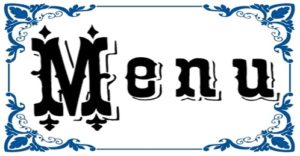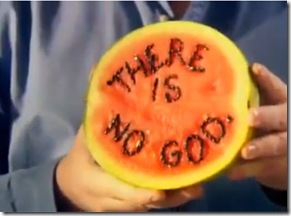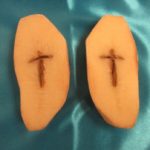 God is everywhere, it seems, even inside potatoes. A couple of weeks ago, a cook at a seniors’ home in Grande-Rivière, Quebec, cut a spud open and found a miracle inside: a cross-shaped cavity, picked out in a tasteful brown. He, and the residents of the home, have taken this to be a sign—a message of hope and comfort from the Big Guy. The miracle murphy is currently being air-dried to preserve it, with a view to putting it on permanent exhibition in the facility’s dining room in a custom-built display case.
God is everywhere, it seems, even inside potatoes. A couple of weeks ago, a cook at a seniors’ home in Grande-Rivière, Quebec, cut a spud open and found a miracle inside: a cross-shaped cavity, picked out in a tasteful brown. He, and the residents of the home, have taken this to be a sign—a message of hope and comfort from the Big Guy. The miracle murphy is currently being air-dried to preserve it, with a view to putting it on permanent exhibition in the facility’s dining room in a custom-built display case.
Actually, God sends a lot of messages in potatoes, generally in the form of a cross. A quick search turns up identical reports from Albuquerque, Berlin, Ohio, Iowa, Bloomington (Texas), The Hague, Hull, and Florida, for starters. Oddly, the miraculous messages found on holy potato chips also tend to take the form of a 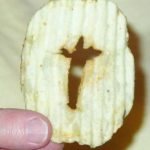 cross. This could mean that potatoes are a particularly Christian vegetable—or it might just be a case of pareidolia meeting potato pathology: a condition called “hollow heart,” where the spud grows too fast for its own good and develops distinctive internal cavities that look cruciform when bisected at an early stage. You decide.
cross. This could mean that potatoes are a particularly Christian vegetable—or it might just be a case of pareidolia meeting potato pathology: a condition called “hollow heart,” where the spud grows too fast for its own good and develops distinctive internal cavities that look cruciform when bisected at an early stage. You decide.
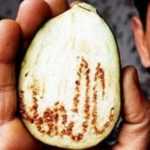 Allah, on the other hand, tends to prefer communicating through eggplants. The patterns of seeds that swirl about the interior are peculiarly well suited to spelling out the deity’s name in Arabic, though examples in Urdu and even English have also been recorded. Food-based miracles, however, do not stop with potatoes and eggplants. Indeed, one could arrange a diverse yet wholly ecumenical Christian-Muslim potluck love-feast, using nothing but edible messages from God.
Allah, on the other hand, tends to prefer communicating through eggplants. The patterns of seeds that swirl about the interior are peculiarly well suited to spelling out the deity’s name in Arabic, though examples in Urdu and even English have also been recorded. Food-based miracles, however, do not stop with potatoes and eggplants. Indeed, one could arrange a diverse yet wholly ecumenical Christian-Muslim potluck love-feast, using nothing but edible messages from God.
Appetizers: potato chips, cheetos, pretzels, marmite on toast.
Main course: pizza, fish sticks, fish, tacos, eggs, tortillas, perogis, grilled cheese sandwiches, pancakes, lamb. These would be accompanied by naan, pita bread, and chapatis.
Vegetables and salads: Eggplants, potatoes, tomatoes, and leeks.
Dessert: ice cream, cinnamon buns, chocolate, KitKats, banana, banana chips, apples, oranges, grapes.
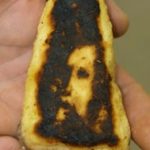 Be honest, though—could you really bring yourself to eat a fish stick bearing a nicely rendered image of Jesus Christ? Or a cinnamon bun with a passing resemblance to the newly sainted Mother Teresa (or maybe Jimmy Durante)? Or a grilled cheese sandwich personally imprinted by the Virgin Mary? In fact, nobody eats these things.
Be honest, though—could you really bring yourself to eat a fish stick bearing a nicely rendered image of Jesus Christ? Or a cinnamon bun with a passing resemblance to the newly sainted Mother Teresa (or maybe Jimmy Durante)? Or a grilled cheese sandwich personally imprinted by the Virgin Mary? In fact, nobody eats these things.
Some of them are put on display as objects of veneration, in the time-honoured tradition of medieval relics and icons. And—again like medieval 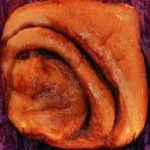 relics and icons—some of them become nice little cash cows. For example, the “nun bun” discovered by a customer in a Nashville coffee shop in 1996 inspired a line of t-shirts and coffee mugs until Mother Teresa herself objected to the use of her name. Shellacked for posterity, it stayed on display in the coffee shop until it was stolen in 2005, possibly resurfacing in Seattle a couple of years later.
relics and icons—some of them become nice little cash cows. For example, the “nun bun” discovered by a customer in a Nashville coffee shop in 1996 inspired a line of t-shirts and coffee mugs until Mother Teresa herself objected to the use of her name. Shellacked for posterity, it stayed on display in the coffee shop until it was stolen in 2005, possibly resurfacing in Seattle a couple of years later.
A surprising number of these nutritious acheiropoieta go up on eBay, though they do not always do well. One that did very well indeed was the famous Marian grilled cheese sandwich—the Golden Palace Casino bought it for $28,000, which I suppose is some kind of miracle.
But atheists, be of good cheer. God may have all those potatoes and eggplants and cheetos and so forth, but we have our very own watermelon.

